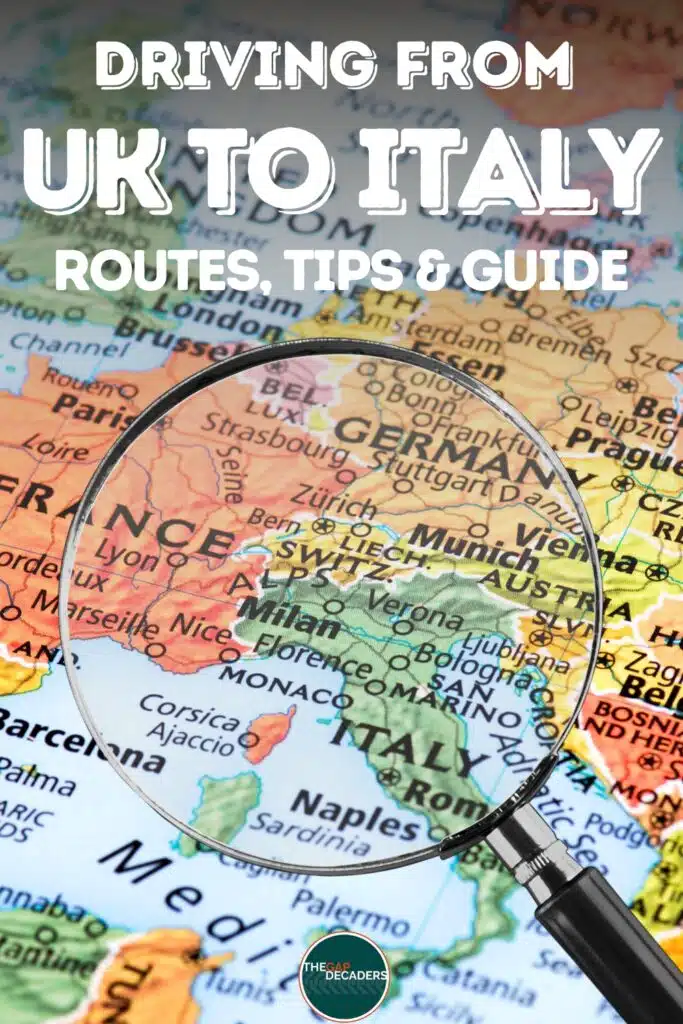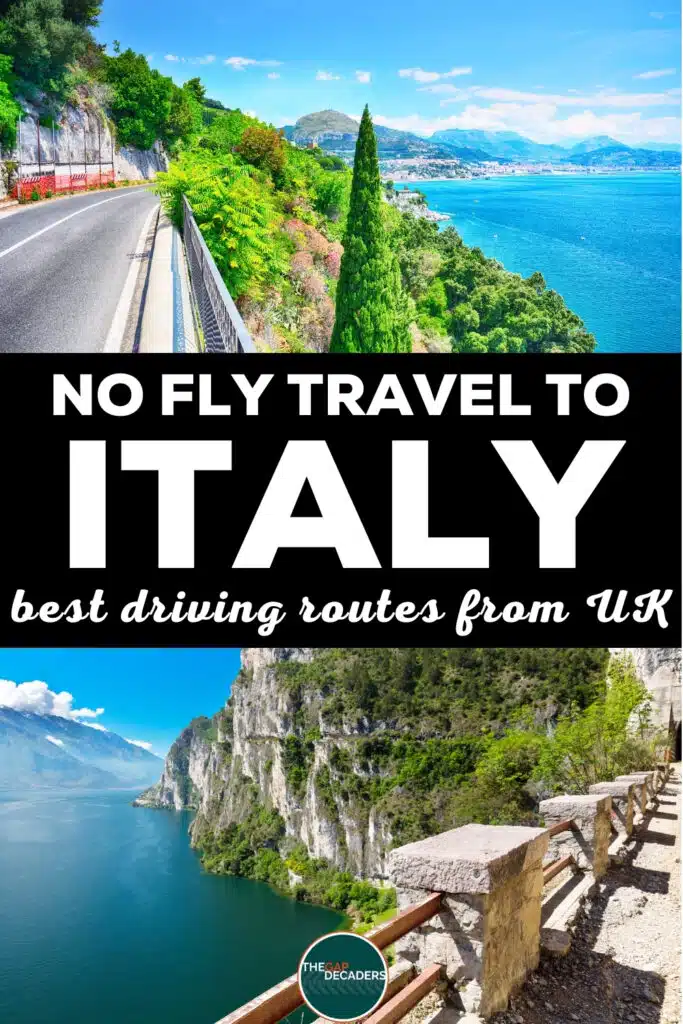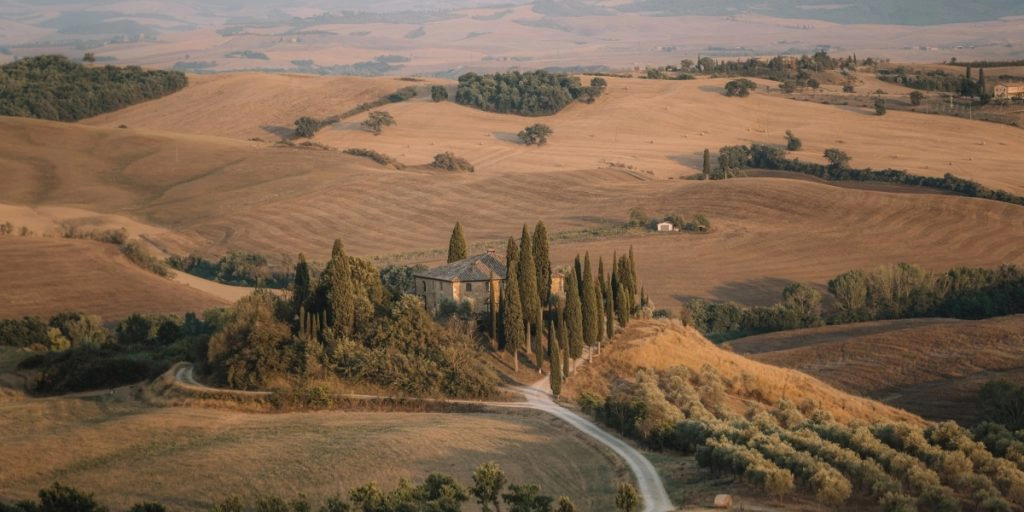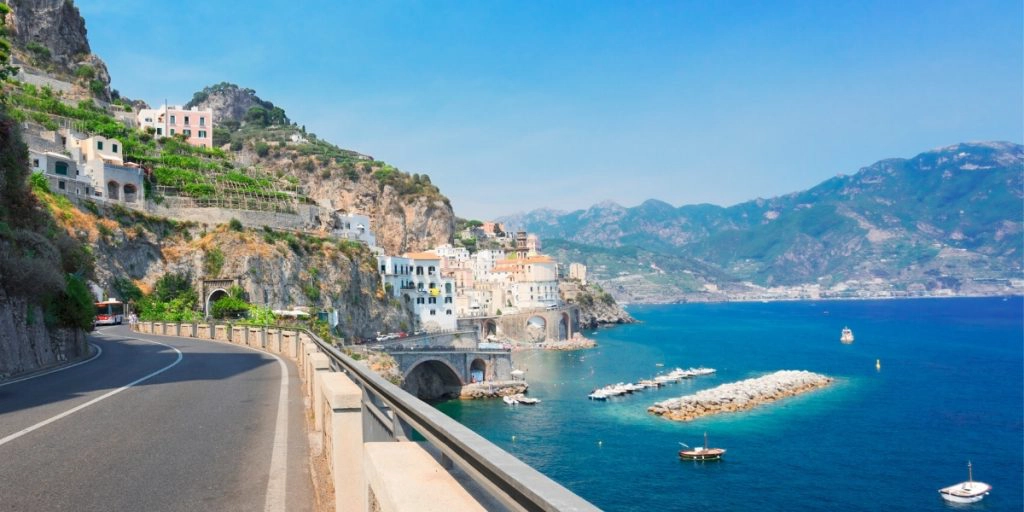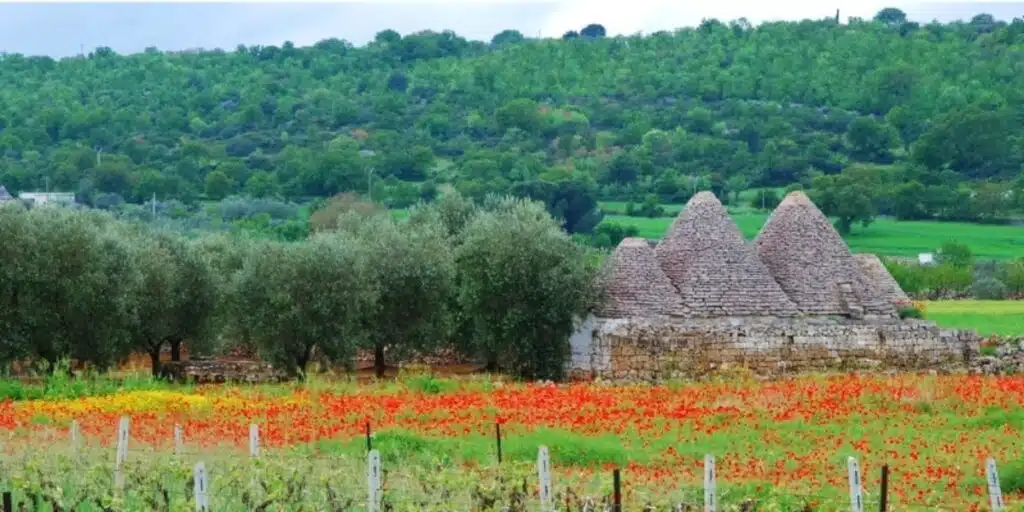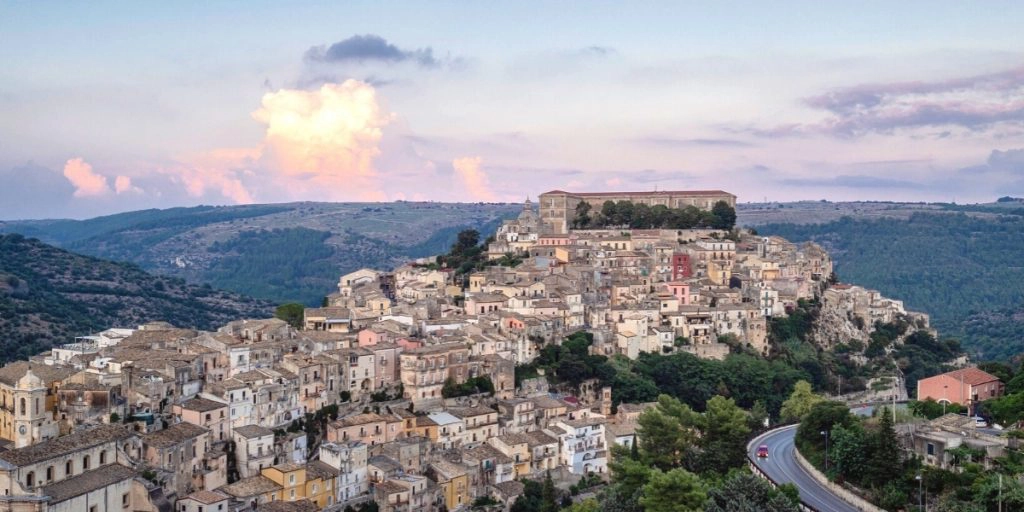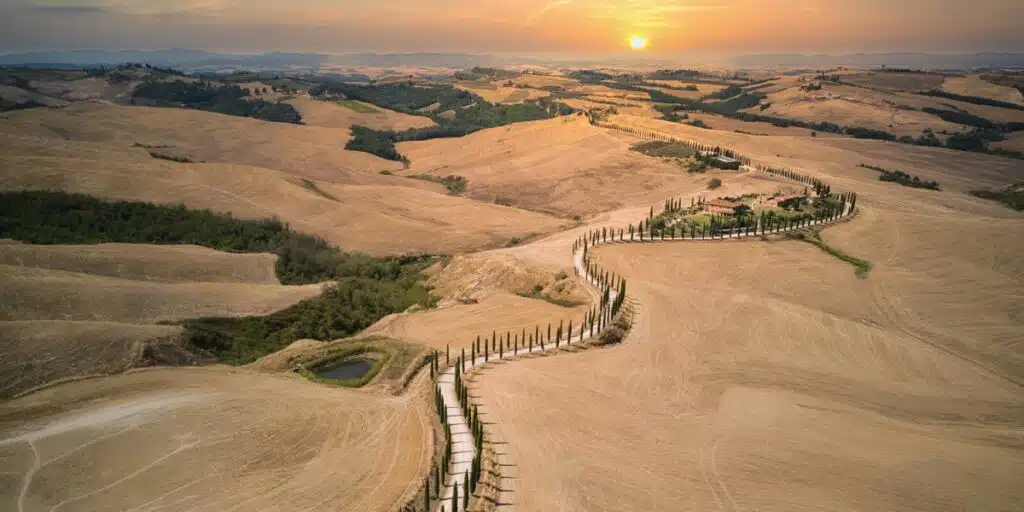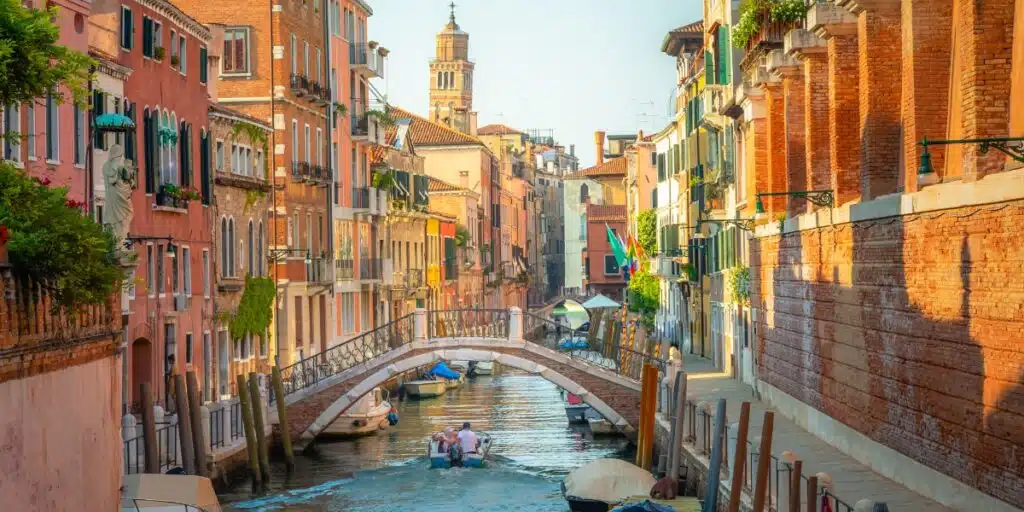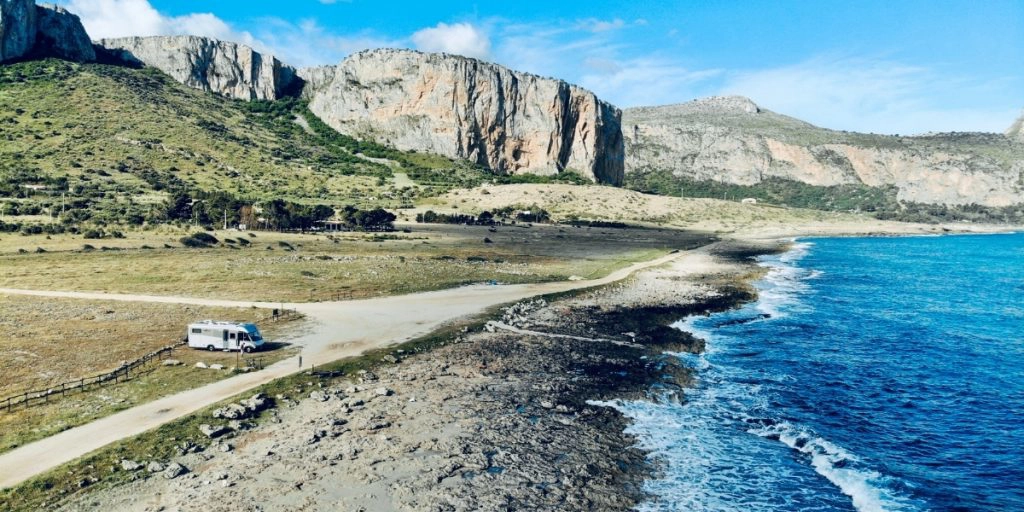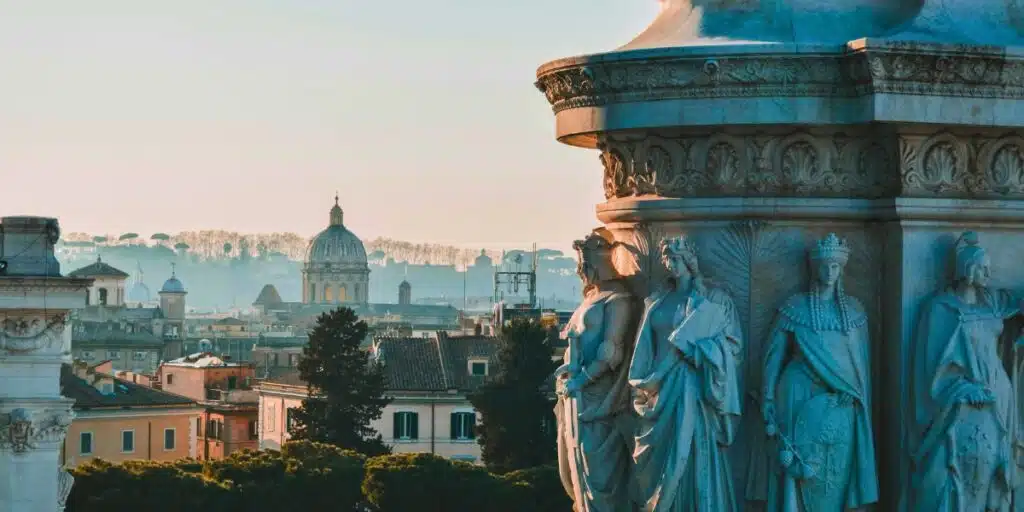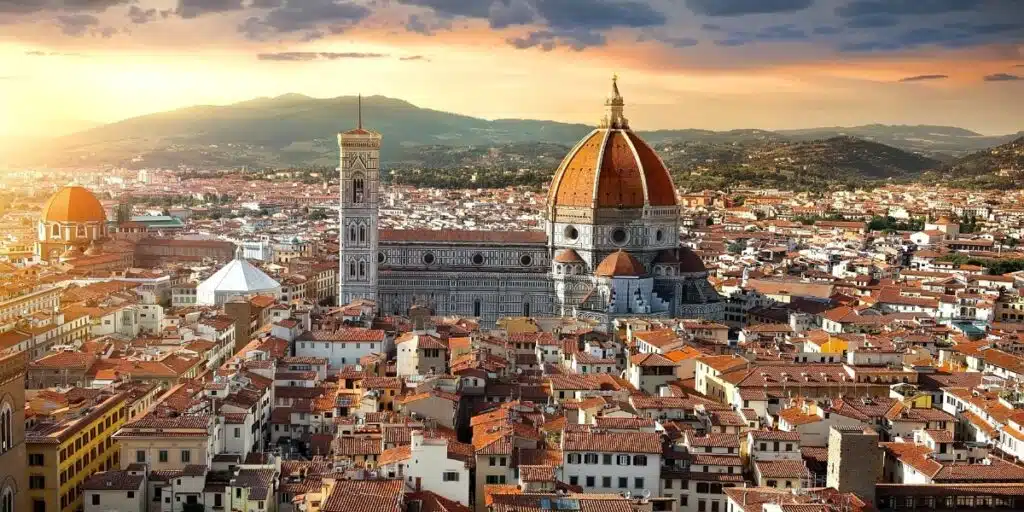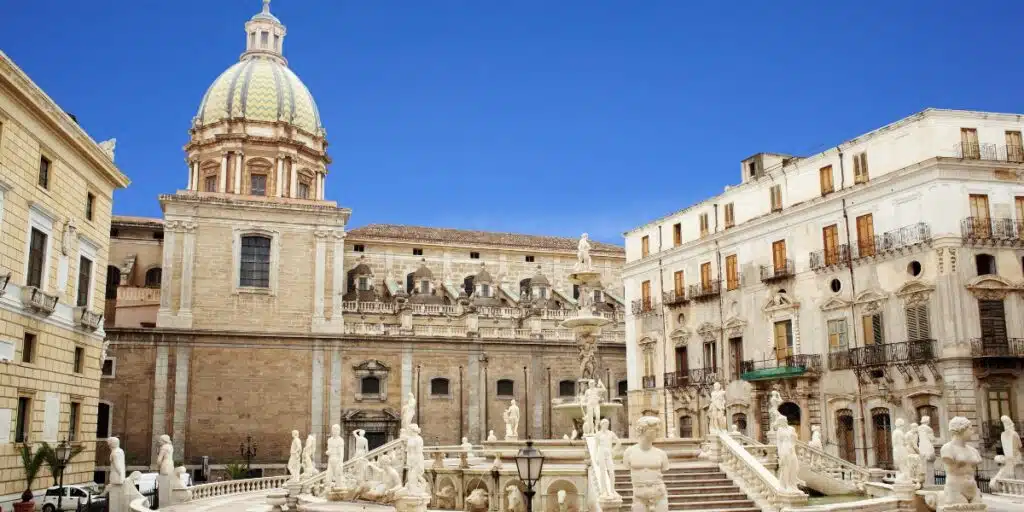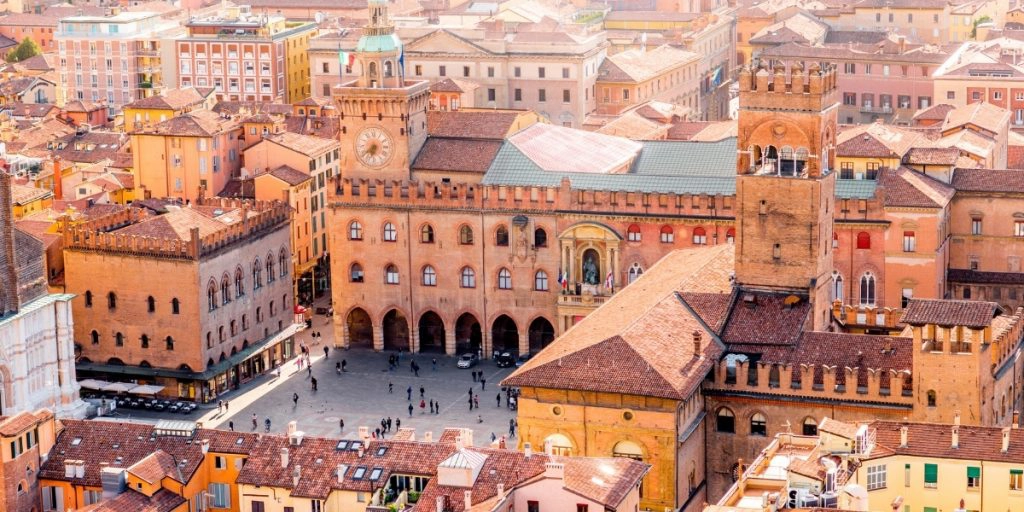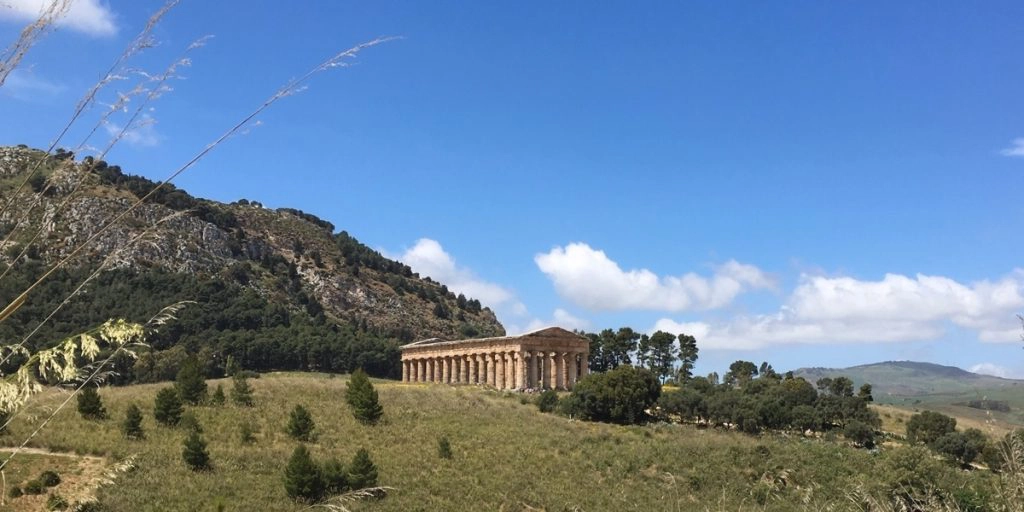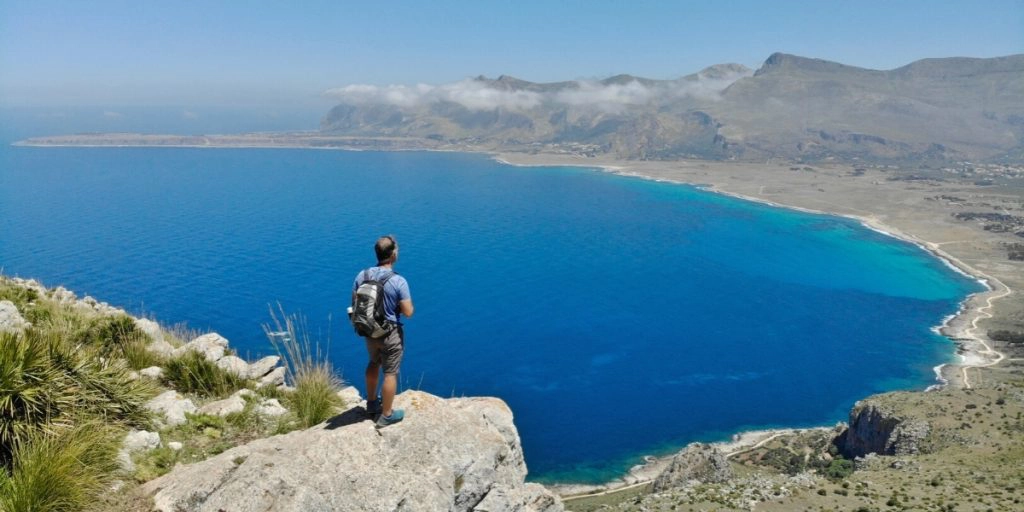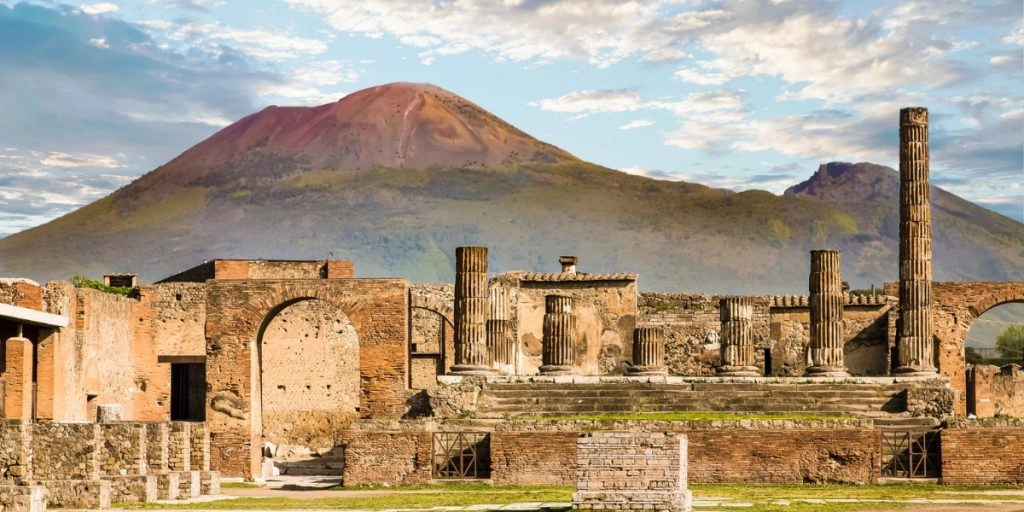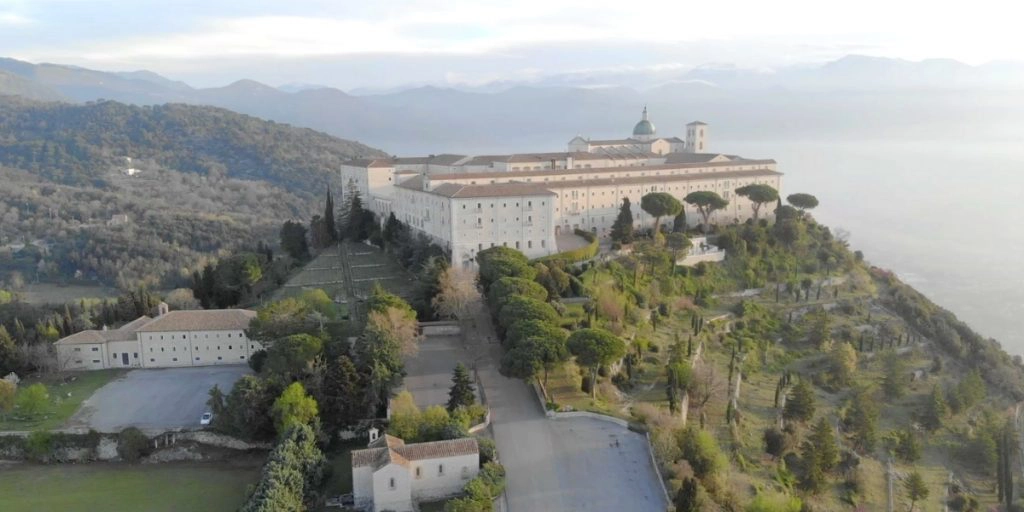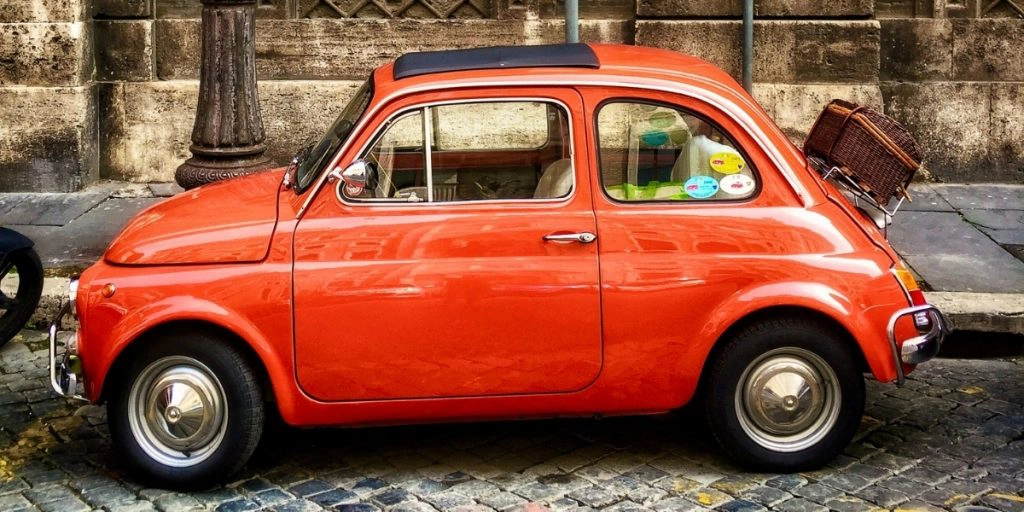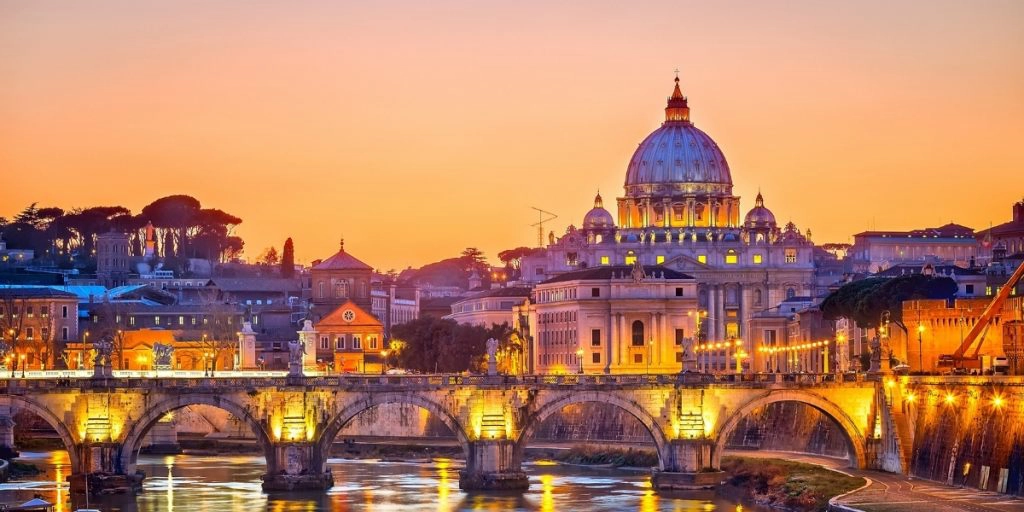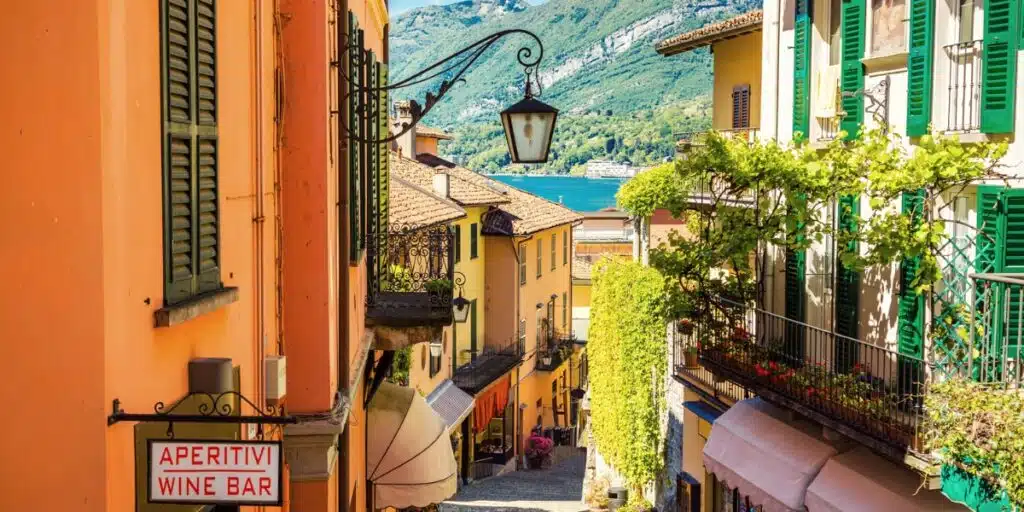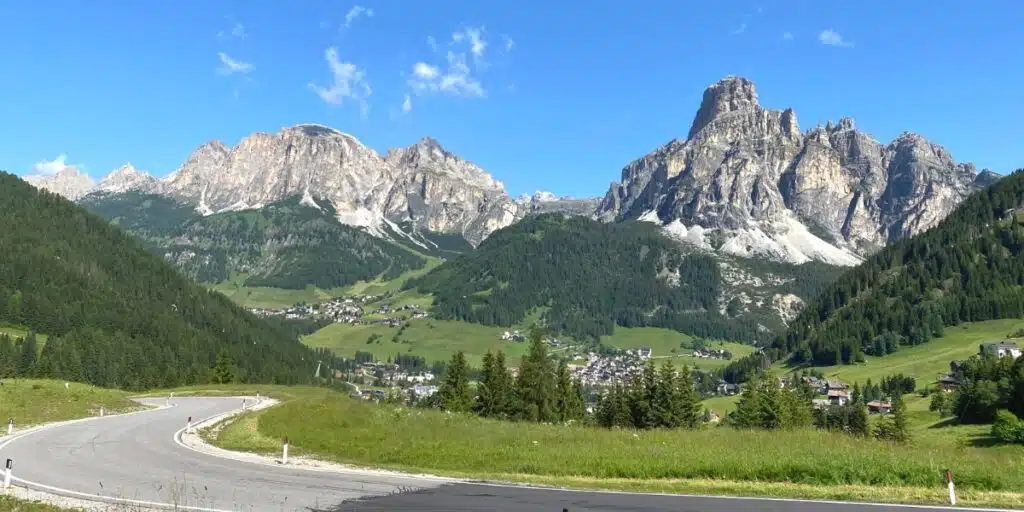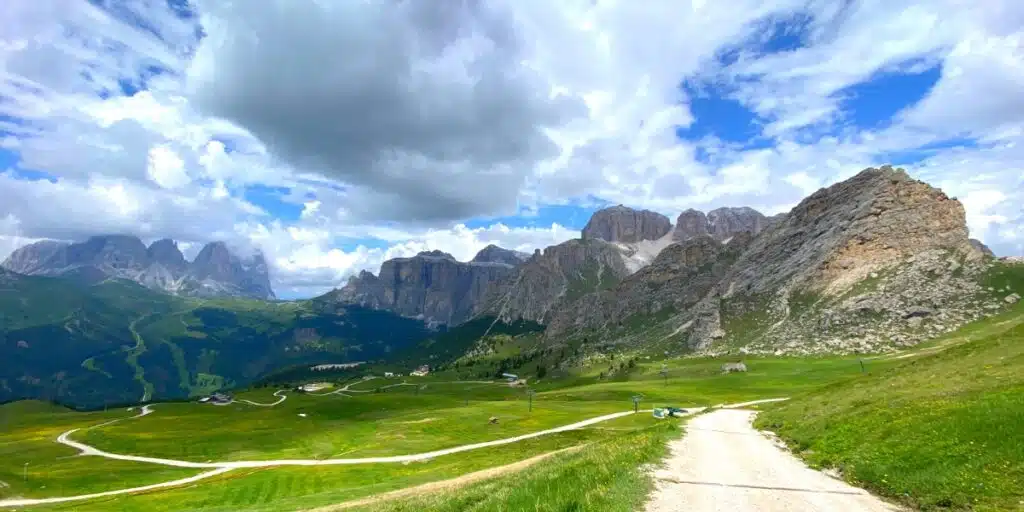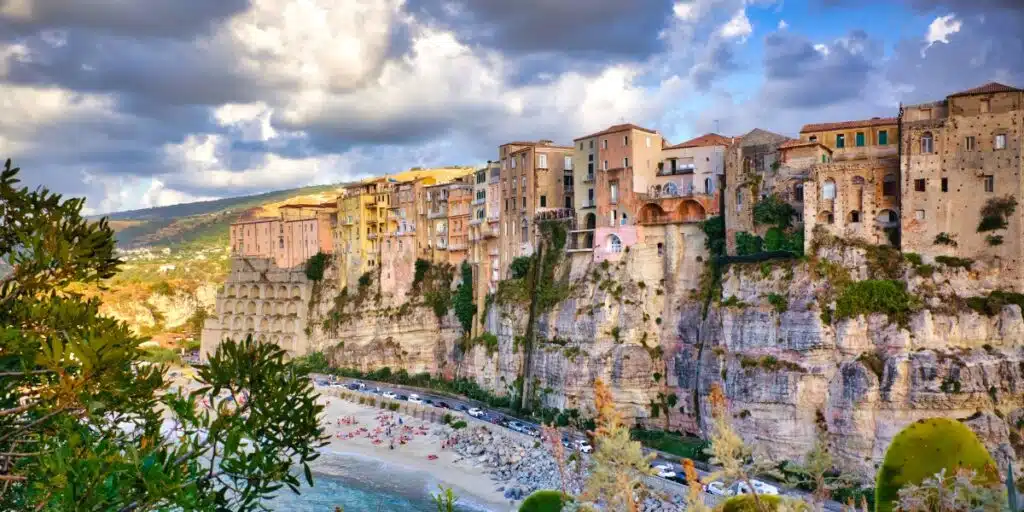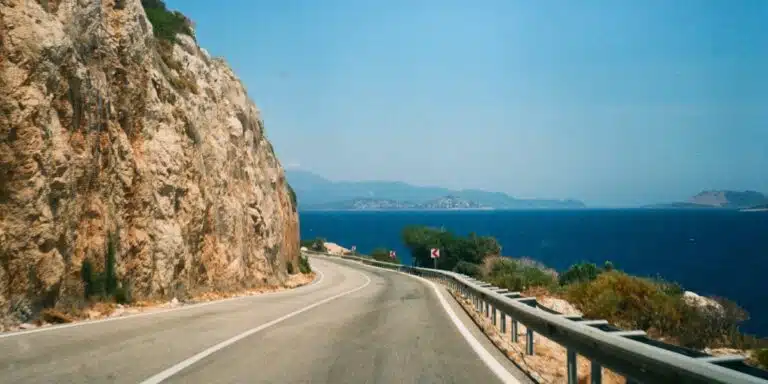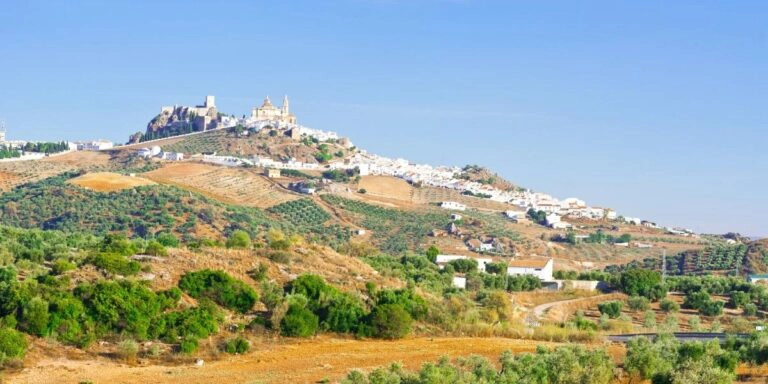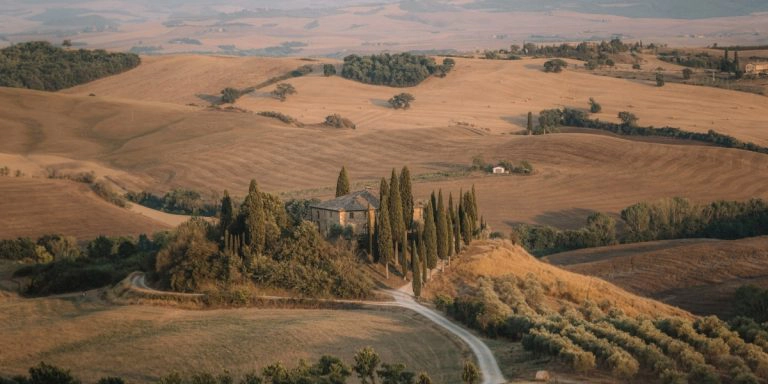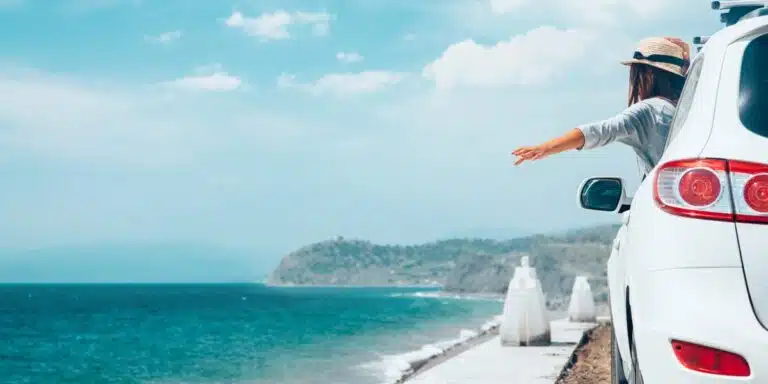This post may contain affiliate links, from which we earn an income. Click here to read our affiliate policy.
The Best Routes to Italy from the United Kingdom
Are you desperate for some Italian culture but don’t want to fly? With great routes across Europe, a road trip from UK to Italy is easy, leaving you arriving refreshed and unstressed, ready to enjoy la dolce vita from the comfort of your own car.
We’ve spent the last five years full-time traveling in Europe and have driven from the UK to Italy more times than we can remember! In this guide for driving to Italy from the UK, we’re sharing the best routes, costs, and tips to help you have the best journey to Italy.
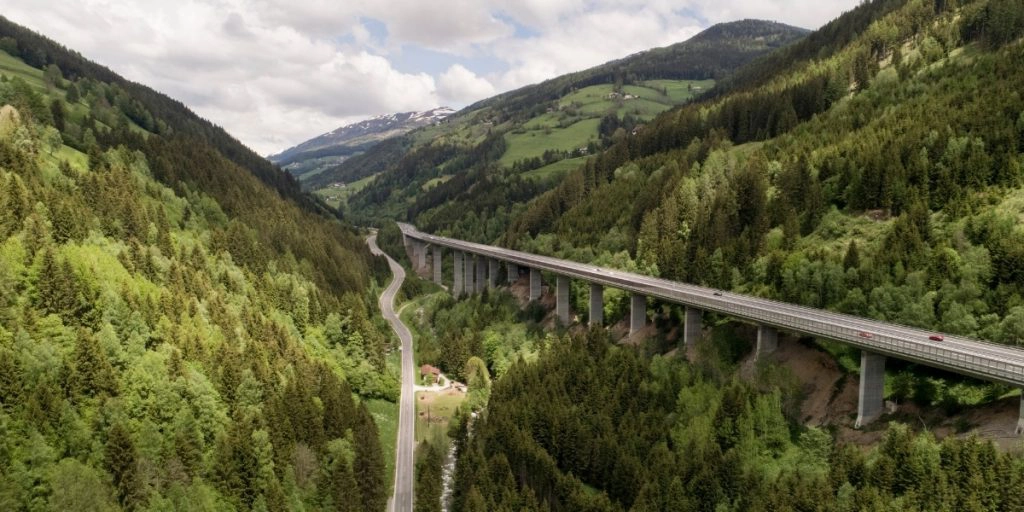
Summary of the best routes to Italy from UK
Crossing the Channel
Before you pick the best route to Italy, you need to work out the best way to get to mainland Europe. These are the best options for crossing the English Channel:
Eurotunnel Le Shuttle
The fastest route is using the Eurotunnel Le Shuttle from Folkestone to Calais. The crossing under the channel takes 35 minutes, and with a fast check-in and loading process, you can be in France in an hour.
This crossing is Ideal if you are driving from UK to France with a dog, or just want to get to the other side as quickly as possible.
Dover to Calais
There is no direct car ferry from the UK to Italy. The quickest way by ferry is the Dover to Calais route, on which both P&O and DFDS operate up to 40 crossings between them in peak season. Taking just an hour and a half, you’ll have time on board for a meal or drink and perhaps a quick snooze.
Getting on and off can take a while though, as they have to piece all the vehicles together like a jigsaw puzzle. Not as quick as the shuttle, but very possibly a bit cheaper, especially if you can be flexible with crossing times.
Eastern England to the Netherlands
More expensive and quite a bit longer than the Dover-Calais route, the crossings from Harwich, Hull, and Newcastle to the Netherlands may prove to be cost-effective, but they are only a better option if you don’t live in the south of England.
The Stena Line Harwich-Hook of Holland route operates daily at 9am, with the crossing taking around seven hours. You’ll need to find an overnight stop on the other side as you won’t get through customs until well after 6pm, unless you can share the driving and go through the night.
If you cross from Hull to Rotterdam with P&O, their daily crossing departs at 8.30pm and takes around eleven hours, meaning you arrive refreshed and ready for a full day’s drive.
The DFDS Newcastle to Amsterdam crossing is also overnight but takes nearly 16 hours and is a bit more expensive, although ideal for those starting their Italian road trip in the north of the UK.
Other Popular Crossings
There are a handful of other routes out of Newhaven and Folkestone to the ports of northern France, which are also worth exploring.
The key here is to be flexible with dates and times to get the best deals, this is where you may just find a bargain.
Is this your first time visiting Italy? Get all the information you need in our Italy Travel Guide, including what to pack, the best time of year to go, getting there and practical tips to help you have the best trip!
The Best Driving Routes from UK to Italy
There are so many main routes to Italy from UK, it can be daunting working out which one to take. Depending on whether you’re doing a straight dash down, whether you’re going to meander and spend a bit of time sightseeing along the way, and your final destination, we’ve got all the best routes from UK to Italy for you.
All our routes routes assume one-way travel from Calais in a 2.5l diesel car and costs have been updated in January 2024. You can find your specific car’s toll costs and fuel consumption at ViaMichelin. For a return journey simply double the statistics, or maybe take a different route back to the UK.
TOP TIP: Make sure you book your hotels in advance, as popular and convenient accommodation with good reviews will be reserved well in advance during peak times.
If you feel daunted by the drive, you could explore the motorail option. This means transporting your vehicle by train whilst you enjoy the journey in a sleeper coach. This is a fantastic way to travel, but an expensive experience.
We took our touring bike from Dusseldorf to Verona (one of the few routes still operating) and saw lots of classic cars being transported this way. Motorail is a great option if you don’t want to add mileage to your vehicle.
You can find out more about European motorail routes with the Man in Seat 61.
RELATED POST: 19 Helpful Long Distance Driving Tips
UK To Italy Driving Routes Map
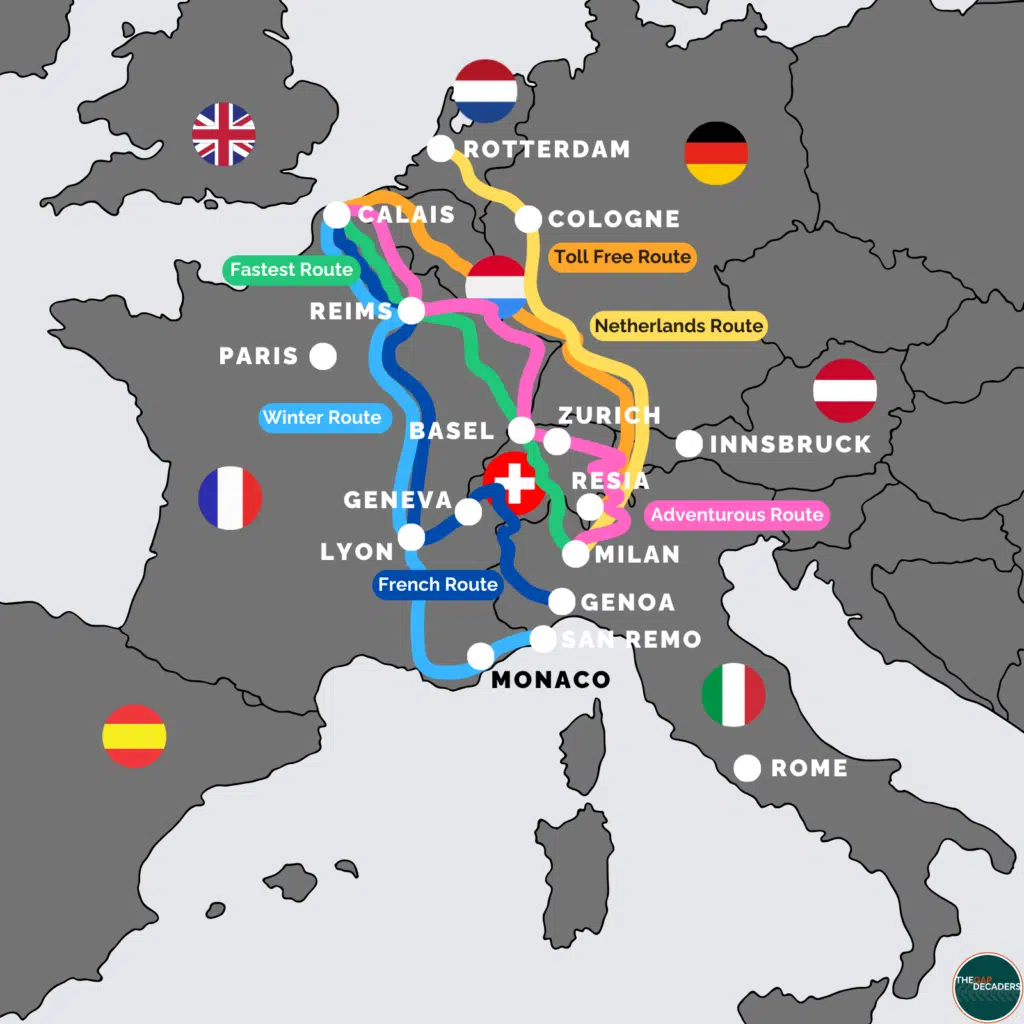
The Quickest Route
Calais – Reims – Nancy – Basel – Lucern – Milan
The quickest drive to Italy from England is the straightest, and probably also the most scenic! Within 2 hours from Calais, you’ll be leaving the flat plains of northern France behind.
This travel route from UK to Italy via Switzerland passes through some of Europe’s most spectacular scenery, especially as you approach the Alps, and snakes between Lake Como, Lake Maggiore, and Lake Lugano en route from Lucerne to Milan.
You could take a few extra days and stop along the route. Pretty Colmar, the tri-national medieval city of Basel, and elegant Lucerne with its gorgeous lake are all worthy of a stop-over.
Driving from France to Italy on this route, you’ll find excellent motorways and national roads as you pass through France and Switzerland before using the free Gotthard Tunnel, Gotthard Pass, or Furka Pass to enter Italy.
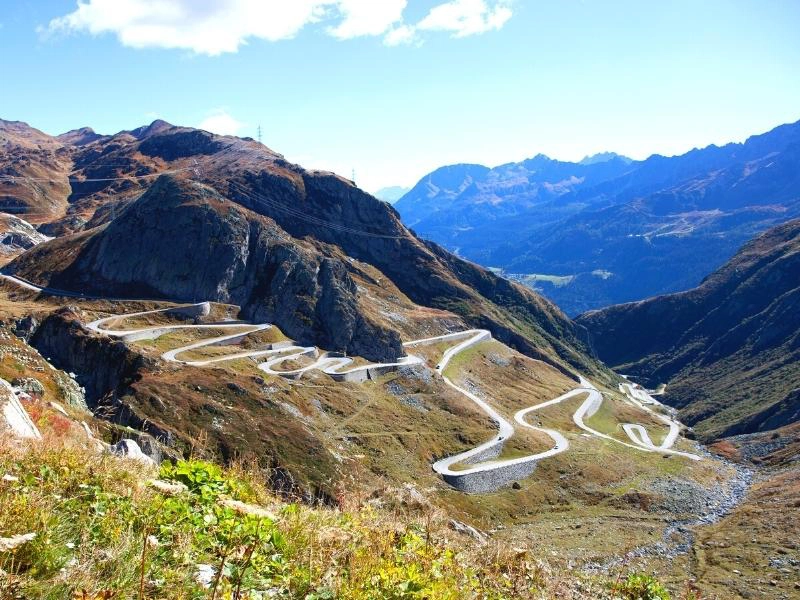
The Toll Free Route
Calais – Lille – Luxembourg – Stuttgart – Kempten – Landeck – Resia
This the perfect route for those looking to avoid the French tolls and requirement for an Austrian vignette. This route is especially good for anyone in a large motorhome over 3,500kgs where tolls costs are higher and a GoBox is required to travel on Austrian motorways.
Head east from Calais using the toll free A16 and A25. Head south through toll-free Belgium and Luxembourg, before driving into Germany. All the autobahns in Germany are toll free for motor caravans, even those over 7,500kgs.
From Langenau, pick up the A7 heading south until you cross the German-Austrian border through the Grenztunnel where the road becomes the B179 Fernpass, then follow these directions for a toll free transition through Austria.
- Continue on the Fernpass B179 past Reutte and over the actual pass to Nassereith.
- Just past Nassereith take the B189 in the Imst direction.
- At Imst take the B171 (being careful not to go onto the parallel A12 toll road) in the direction of Landeck.
- At Landeck take the L76 to Fließ then the B180 south in the direction of Reschenpass/Reschen/Resia and then into Italy.
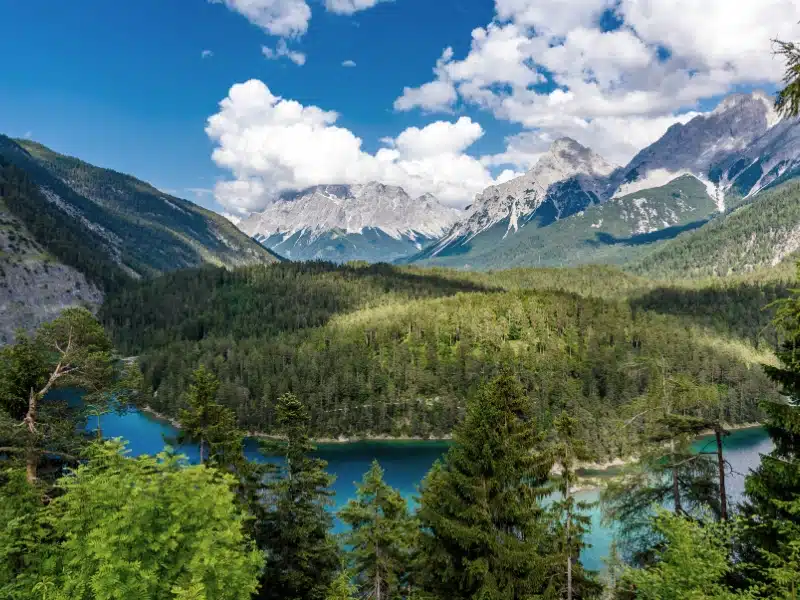
The French Route
Calais – Reims – Troyes – Dijon – Lyon – Geneva – Turin – Genoa
If you want the convenience of the fast French autoroute (motorway) all the way on your drive from England to Italy, and a straightforward trip, then this is the best way for you.
The section from Lyon as you skirt around Lake Geneva is also incredibly picturesque, and it’s a good place to stop if you’re not doing the drive in one long stretch.
Utilizing the Mont Blanc tunnel to get through the Alps is also a good route if you’re planning a northern Italy road trip, heading for the Italian Riviera, the historic city of Turin, or driving to Tuscany from UK, but you’ll pay for the privilege with higher French motorway tolls and a hefty €46.30 one way for the tunnel.
RELATED POST: Driving in the Alps: Top Tips & Best Routes
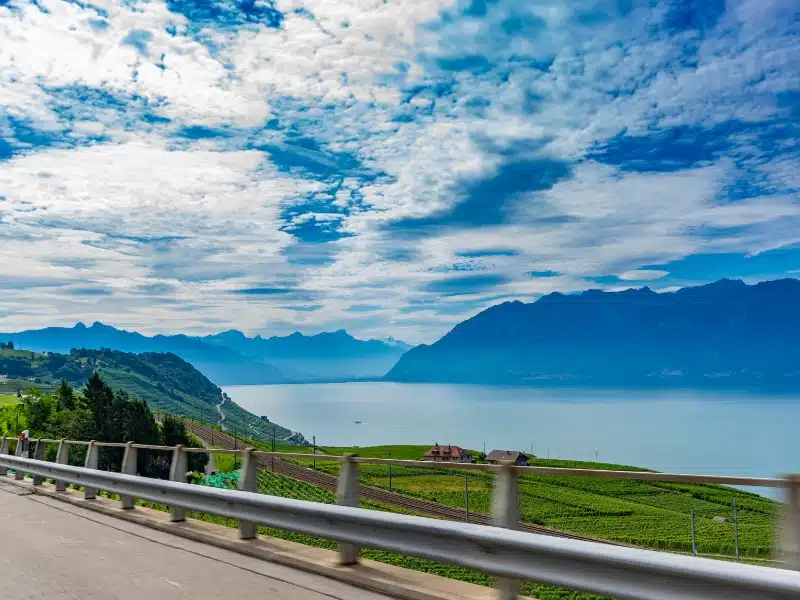
The Netherlands Route
Rotterdam – Cologne – Koblenz – Ulm – Milan
If you’re leaving from one of the eastern England ports, then traveling down through Germany is super cost-effective as their autobahns are free of charge, unless you’re a commercial truck driver!
If you’re driving from England to Germany before traveling on to Venice or Lake Garda, the most easterly of the Italian Lakes, head for Innsbruck from Ulm and cross into Italy via the beautiful Brenner Pass for an extra cost of €10 in toll fees.
RELATED POST: Road Trip on a Budget: 36 Tips to Save Money in Europe
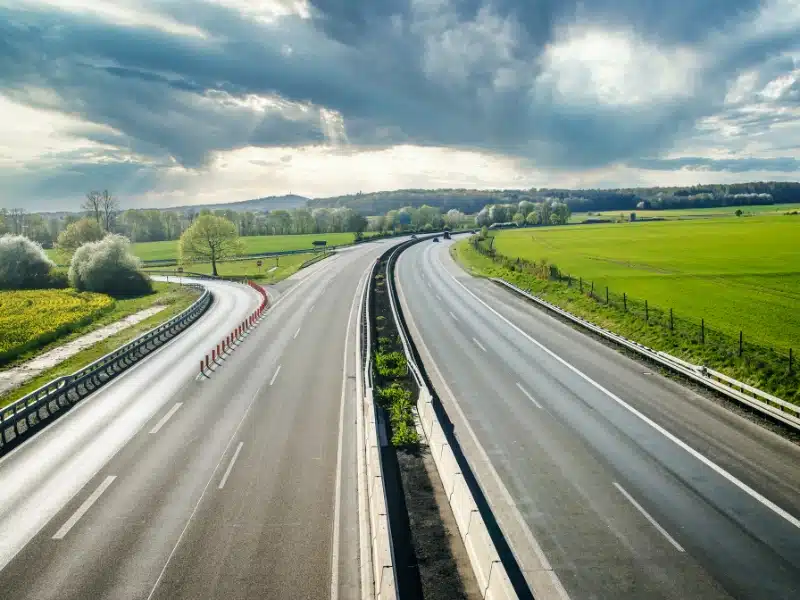
The Winter Route
Calais – Reims – Troyes – Dijon – Lyon – Avignon – Nice – San Remo
Almost all of the Italian border is mountainous. If you’re traveling to Italy in the winter but don’t fancy the weather conditions or crossing the mountain roads of the Alps to get there, then you need to drive right down to the Cote d’Azur on the south coast of France and turn left.
The coast road is simply stunning, and in winter won’t be rammed with tourist traffic. You’ll cross into Italy, just west of Menton on the infamous SS1 road, sections of which were used in a James Bond movie.
This is the best route in winter to avoid the big mountains, but you’ll still need to fit winter tires or carry snow chains to satisfy the French mountain law.
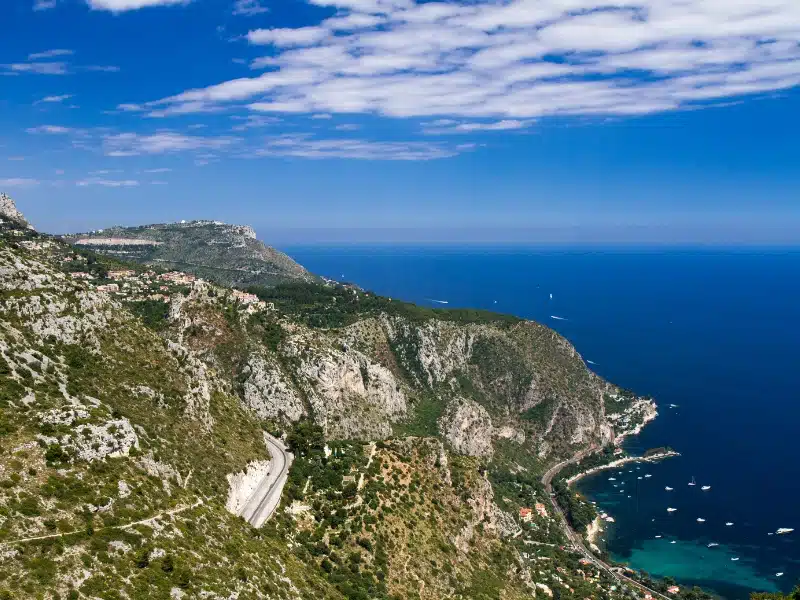
The Adventurous Route
Calais – Reims – Colmar – Zurich – Davos – Stelvio Pass – Bormio – Milan
This route is the best option if the road trip to Italy is more important than the destination. Crossing three breathtaking passes, surrounded by the might of the Alps as you head east from Davos, the highlight of the route is the incredible Stelvio Pass, beloved by motorcyclists, classic car enthusiasts, and even the occasional motorhome.
This route is only suitable for the summer months, even crossing as late as June you may still find snow right at the top of the passes. From May to September, the roads are likely to be clear, but it always pays to check the weather before you set off when driving in northern Italy.
RELATED POST: Stelvio Pass: The Best Mountain Road in Italy?
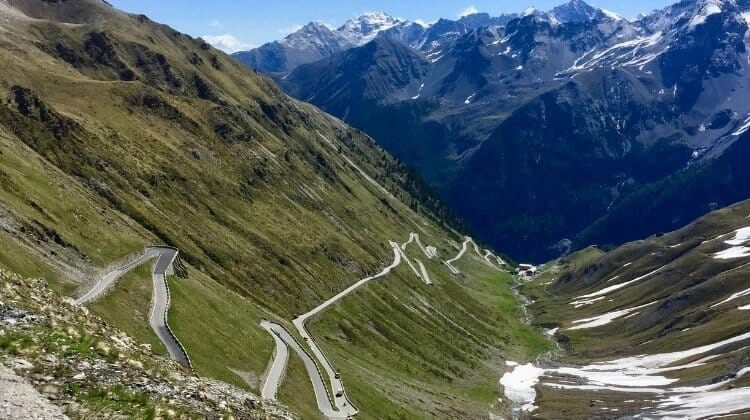
The “I want to stop and see everything on the way” Route!
This is a much harder-to-define route because it depends so much on what you like doing and the type of sightseeing you enjoy. Here are some ideas of the best places that could be along a route to Italy!
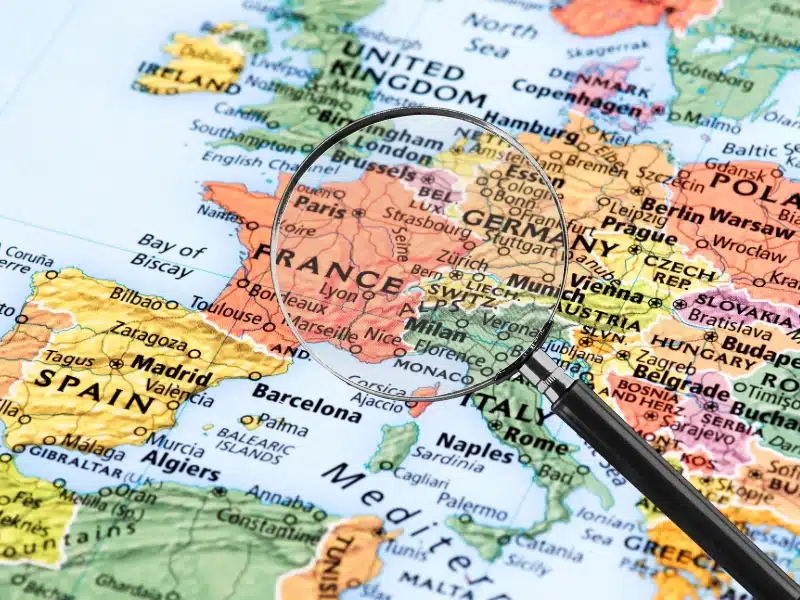
Make sure you have travel insurance you can trust when driving to Italy. We recommend True Traveller for their 5-star TrustPilot reviews, variety of cover options, best activities cover as standard, great prices, and excellent service.
Onward Travel in Italy
You’ve arrived! Generally speaking, driving in northern Italy is a pleasure, the roads are in good condition and well-maintained.
However, the further south you venture, the worse the roads become. Once south of Rome, you’ll find worn and potholed A roads and autostrada, but take it easy, follow our Italy driving tips, enjoy the gorgeous scenery and you’ll soon feel at home.
Italy Travel Ideas
Driving on the Continent
Whichever route you choose, driving from UK to Italy means crossing through one or more other countries in Europe such as France, the Netherlands, Germany, and Switzerland. This means you need to familiarise yourself with the rules of driving in each country.
Thankfully, there are some common laws and regulations across most European countries for visitors from the UK and elsewhere. Make sure to carry the correct documentation and understand EU driving rules.
RELATED POST: Driving in Europe – Everything You Need to Know
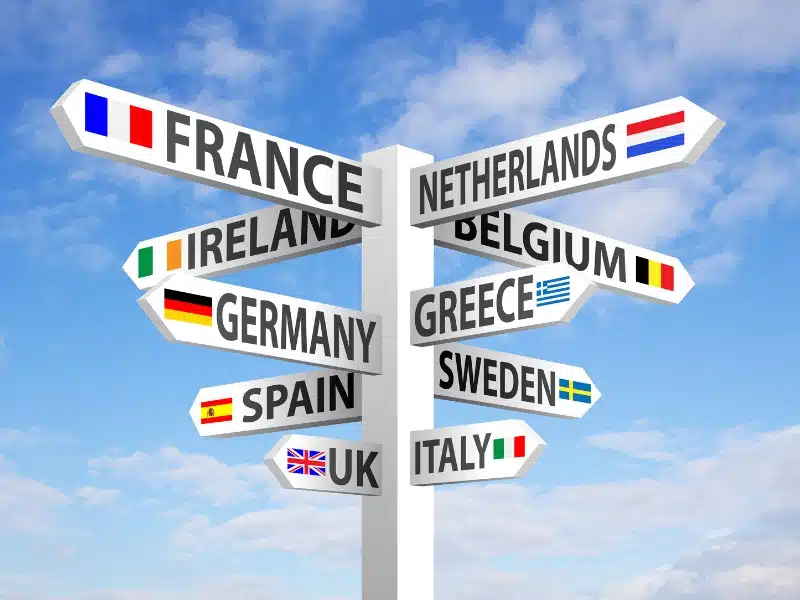
Don’t forget your road trip essentials! Our free road trip checklists help you remember everything, including road trip snacks, podcasts, and road trip songs for the journey!
Driving in Italy
The quality of the roads and the abilities of Italian drivers are mixed, especially outside of the major cities. The further south in Italy you go, the more the road network requires investment.
So, I hear you ask, is driving in Italy safe? Yes! the important thing is to be aware of the challenges and obstacles and go slowly until you find your feet. Do that and you’ll be perfectly safe.
Toll Roads in Italy
Italy’s motorways are called autostrada, and you’ll notice that the Italian road signs for motorways are green and not blue. Not all autostradas have tolls or only have them on some sections.
Toll roads in Italy are much cheaper than they are in France and as a general rule, it is far cheaper, easier, and quicker to take the toll roads in Italy. This is because of the sometimes poor construction of country roads, although we did see potholes on toll roads on occasion!
Italian toll roads are pay-as-you-go at toll booths. Use the correct money or your credit card as often there is no change at the machine.
Alternatively use a Bip&Go, Tollbird, or Telepass device that allows you to pass without using the non-barrier lanes and pay via a linked credit card.
Low Emission Zones in Italy
Italy has many different low-emission zones with differing standards, time periods, and enforcement methods. You’ll find these mainly in northern Italy, but also in mid-Italy and Sicily. In Milan and Palermo, these schemes combine LEZ and urban road tolling schemes. Check here what the requirements are if you’re planning to visit a city centre.
In parts of Italy, the historical centers of large cities and major towns restrict traffic from entering areas known as ‘Zone a Traffico Limitato’ or ZTLs. You can expect to receive a fine by post if you drive your car into a signed ZTL as only residents are permitted to use these old town roads, so don’t go there!
In Cinque Terre, along the Amalfi Coast, and in many of the small villages of Tuscany and Umbria, cars are banned altogether from entering towns and villages. The good news is that the municipality usually provides free parking, and if the historic center is not within walking distance, a shuttle bus.
Winter Tyres in Italy
Winter tires are surprisingly not always mandatory when driving Italy, but if you see a sign with ‘obbligo di pneumatici invernali o catene a bordo’, you must either be using winter tires or snow chains.
Whether the signage is in place is determined by local authorities and it can be difficult to know where tyres and chains may be required in advance.
There are a number of exceptions to this ‘sign rule’. Between 15th October and 15th April Italian law makes winter tyres mandatory in the Aosta Valley. If you have summer tires fitted in this area, you will need to carry snow chains between 15 October and 15 April. In addition, you must use winter tires from 15th November to 15th April in South Tyrol, the municipality of Bozen, and the Brenner motorway.
Parking in Italy
It is important to note the different coloured spaces when parking in Italy.
Yellow lines are for disabled parking, white lines mean the parking space is for residents, and blue lines indicate paid street parking.
HELPFUL TIP: If you intend to park your car overnight, check local signs which indicate when street cleaning is done. Cars left in a street where cleaning is scheduled will be towed away!
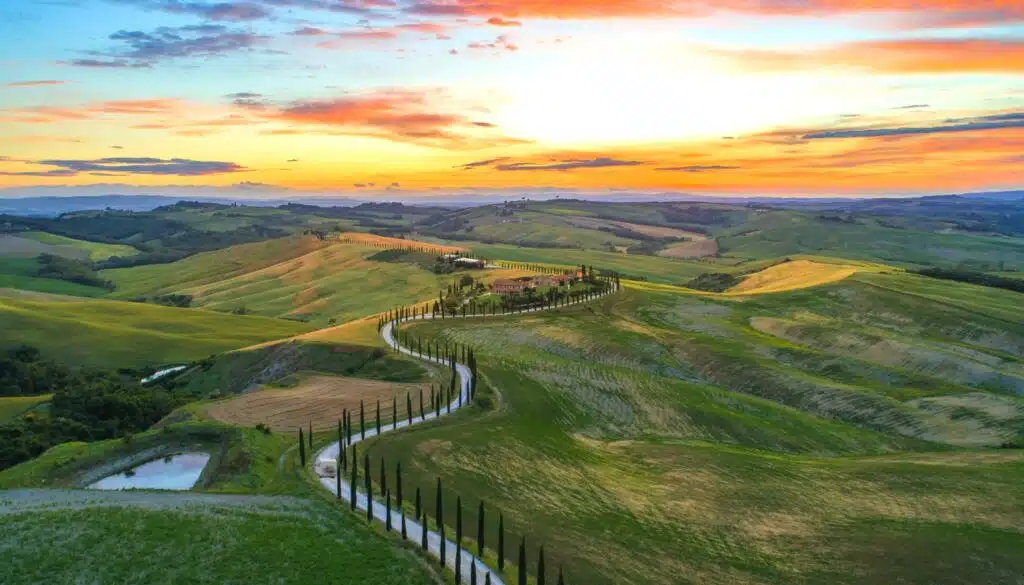
Looking for the best SIM card deals in Europe for your trip? Check out our guide to the best data SIMs in Europe and get the best deal for your trip to Italy.
Driving in France
Driving from UK to Italy through France is easy, with well-maintained roads and generally considerate and well-mannered drivers.
On the downside, France is one of the most expensive countries in which to drive and travel in Europe due to the high fuel costs and expensive tolls, especially if you’re traveling in a larger vehicle like a camper van or motorhome.
There are also regular disruptions and fuel blockades due to political tensions, so make sure you check the current situation when you leave home.
Follow these tips for a safe and easy transit through France on your road trip to Italy from England.
Mountain Law in France
On 1 November 2021 the Loi Montage II or ‘mountain law II’ came into force in 48 French mountainous departments within the Alpes, Massif Central, Jura, Pyrenees, and Vosges regions.
Anyone traveling in a vehicle through one of these areas between 1 November and 31 March will be obliged to fit four approved winter tires or carry at least two snow chains or socks in the vehicle. You can find out more about France’s mountain law here.
Motorway Breakdowns in France
French motorways are privately managed and you’re not allowed to request your own assistance company to attend to you if you break down.
If you do break down, you should use the orange emergency telephones that are situated every 2km along French motorways to call the police or the official breakdown service operating in that area. Alternatively, if no orange telephone is available, you should call the emergency services by calling 112.
You will be towed to a safe designated area where you can make onward arrangements for your own breakdown insurer to assist if you have it. Otherwise, the towing company will be able to provide support or signpost you.
Charges for assistance on a motorway are fixed by the government and are reviewed and revised each year. Many of the government-appointed towing services allow large insurers to pay them directly, but this is at their discretion and will depend on who your European breakdown cover is with.
If this is not the case, you should pay directly and then seek recompense from your insurer.
Motorway Tolls in France
Driving through France can be hideously expensive if you only use toll roads, but they do allow you to travel through the country to your destination quickly.
You may want to consider carrying an electronic toll tag, like Bip&Go or Tollbird, both of which cover you in France and Italy, and deduct the fees from a credit card automatically, meaning you don’t have to stop at a booth or barrier.
Crit’Air Vignettes
France has introduced ‘clean air’ windscreen stickers as a legal requirement in many of its cities, towns, and their peripheries, to identify a vehicle’s emissions levels and to restrict access in order to improve air quality.
This six-category sticker system is designed to identify what emissions vehicles produce, and are categorized based on your vehicle’s Euro emissions standard. These are known as Crit’Air stickers and you may need one for your vehicle, depending on where you visit or stop as you transit through.
If you intend to travel close to a city or use its ring road, it’s worth getting the sticker, which costs €4.61 from the official website. Find out more and purchase Crit’Air stickers from the official certificat-air.gouv.fr website.
RELATED POST: France Road Trip – 13 Amazing Itineraries
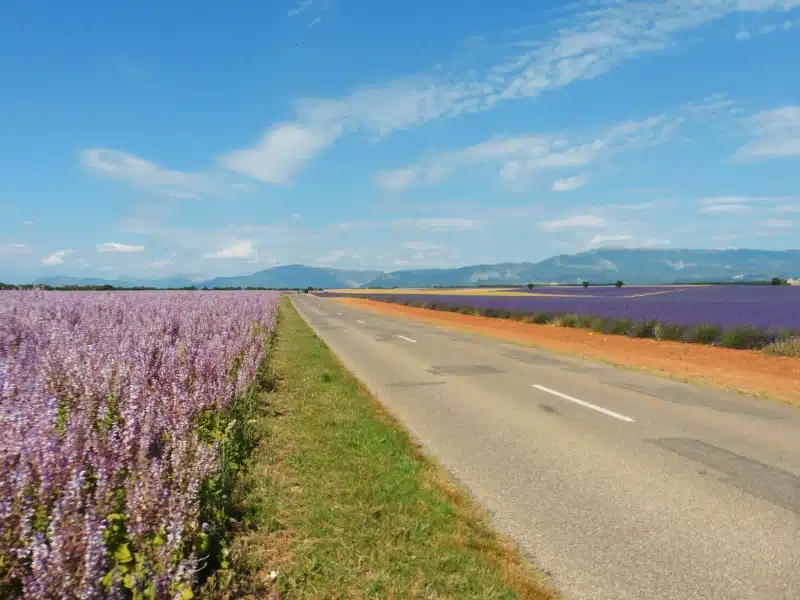
Don’t forget your road trip essentials! Our free road trip checklists help you remember everything, including road trip snacks, podcasts, and road trip songs for the journey!
Driving in Germany
Germany Motorway Tolls
There are no tolls to pay on the motorways, making autobahn routes through Germany a really cost-effective way to access Italy, Switzerland, Austria, Liechtenstein, the Czech Republic, and Poland.
If you are traveling in a massive motorhome camper that is over 7,500kg, like an RV, overland truck, or converted lorry, then you are exempt from the tolls placed on commercial lorries over this weight.
Low Emission Zones in Germany
There are currently 75 umweltzonen or low emission zones in more than 70 cities and built-up areas in Germany.
To enter LEZs in Germany you will need an umweltplakette or environmental sticker which you place on the windscreen to show the level of your vehicle’s emissions. This determines whether you can drive into the LEZ areas in your vehicle.
To purchase these environmental stickers, you must be able to evidence that the vehicle meets the Euro 4 standards for a green sticker, by providing copies of the V5C for newer vehicles (manufactured after January 2006), or a Certificate of Conformity provided by the manufacturer.
Head to the Umwelt-Plakette.de website for more information and to get your sticker – you will need to do this at least six weeks before departure to give it time to be processed and arrive in the post.
RELATED POST: Five Unmissable Germany Road Trip Routes
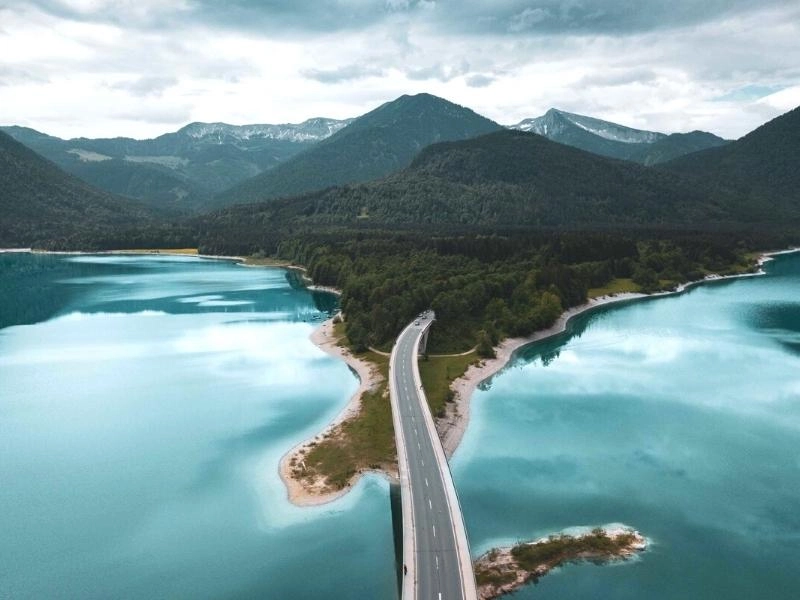
Driving in Switzerland
Traveling in Switzerland by car is a pleasure. The roads in Switzerland are well maintained and the drivers are courteous and measured. The engineering of the mountain passes and complex tunnels and bridges that ribbon across the landscape is a real marvel.
Toll Roads in Switzerland
Switzerland requires you to purchase a vignette (a type of sticker) to use their motorway systems. A vignette sticker can be purchased at fuel stations or online here in advance of your trip.
Buying your vignette online is a good idea, even with your satnav set not to use motorways, you can easily find yourself on one as you pass through without even realizing it, and fines for non-compliance can be large. You need an extra vignette for a trailer and a different type for motorhomes and campervans over 3,500kg.
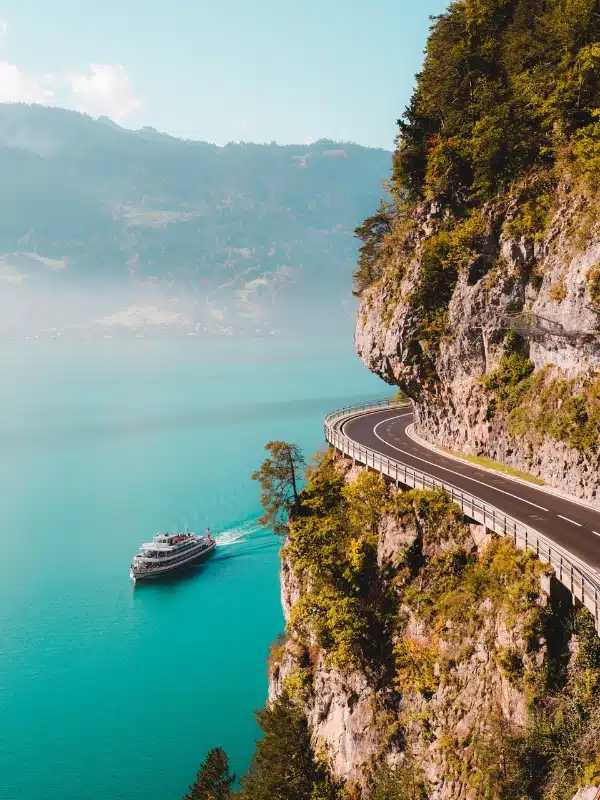
Driving to Italy FAQ
Is it possible to drive to Italy from UK?
Yes, you can easily drive to Italy from UK. You’ll need to take a ferry or the channel tunnel train to get to Europe before picking one of our tried and tested routes to Italy.
Is it cheaper to drive or fly to Italy from UK?
It’s very hard to say because there are so many variables. If you have the time, then driving will be more cost-effective than flying and hiring a car on arrival in Italy. If you’re relying on public transport in Italy or only visiting one location, then flying may be cheaper.
What is the fastest route from UK to Italy?
The fastest route from UK to Italy is via Calais, Reims, Nancy, Basel, and Lucern before you cross into Italy using the Gotthard Tunnel. This route is 1026km (638 miles) and will take around 11 to 12 hours of driving time.
How long does it take to drive to Italy from UK?
There is no really quick way of driving from England to Italy. It can take a minimum of 11 hours from Calais to a couple of days by the time you’ve accounted for rest stops unless you’re traveling with someone who can share the long hours at the wheel.
Are you looking for road trip inspiration? check out these top posts…
European Road Trip: Six Countries in 90 Days
Norway Road Trip: Four Unmissable Routes
Germany Road Trip: 8 Unmissable Routes
The Perfect Andalucia Road Trip: 10-14 Day Itinerary
The Ultimate Bucket List Italy Road Trip
Spring Road Trip from Britain to Portugal
Love it? Pin it!
